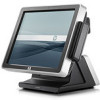HP ap5000 Quick Setup & Getting Started HP ap5000 All-In-One Point of Sale - Page 15
Configuring the COM Port for the VFD Customer Display, Downloading Microsoft Windows Updates - drivers
 |
View all HP ap5000 manuals
Add to My Manuals
Save this manual to your list of manuals |
Page 15 highlights
Configuring the COM Port for the VFD Customer Display You can connect the VFD customer display to either the COM1 port or the COM2 port. The COM port must be configured for 5 volts in the Computer Setup utility for the VFD customer display to function properly. The VFD is connected to the COM2 port from the factory and the COM2 port is already configured for 5 volts. NOTE: Do not connect the VFD customer display to the COM3 port. 1. Press the power button to turn off the computer. 2. Press the power button again to turn on the computer and press the F10 key before the system boots to the operating system to enter the Computer Setup utility. 3. Note which COM port (COM1 or COM2) on the rear panel is connected to the VFD customer display. 4. In the Computer Setup utility, go to Advanced > Super IO Configuration > Serial Port1 Standard Mode/5V or Serial Port2 Standard Mode/5V and change the setting to 5 V. NOTE: If you set the Serial Port2 Standard Mode/5V port to 5 V, you must set the Serial Port1 Standard Mode/5V to Standard Mode. Likewise, if you set the Serial Port1 Standard Mode/ 5V port to 5 V, you must set the Serial Port2 Standard Mode/5V to Standard Mode. 5. In the Computer Setup Exit menu, select Save Changes & Exit. Downloading Microsoft Windows Updates 1. To set up your Internet connection, select Start > Internet Explorer and follow the instructions on the screen. 2. Once an Internet connection has been established, press the Start button. 3. Select the All Programs menu. 4. Select the Windows Update link. In Windows 7, the Windows Update screen appears. Select View available updates and make sure all critical updates are selected. Select the Install button and follow the instructions on the screen. In Windows XP and Windows Embedded POSReady 2009, you will be directed to the Microsoft Windows Update Web site. If you see one or more pop-up windows that ask you to install a program from http://www.microsoft.com, select Yes to install the program. Follow the instructions on the Microsoft Web site to scan for updates and install critical updates and service packs. It is recommended that you install all of the critical updates and service packs. 5. After the updates have been installed, Windows may prompt you to reboot the machine. Be sure to save any files or documents that you may have open before rebooting. Then select Yes to reboot the machine. Installing or Upgrading Device Drivers When installing optional hardware devices after the operating system installation is complete, you must also install the drivers for each of the devices. If prompted for the i386 directory, replace the path specification with C:\i386, or use the Browse button in the dialog box to locate the i386 folder. This action points the operating system to the appropriate drivers. ENWW Installing and Customizing the Software 9















